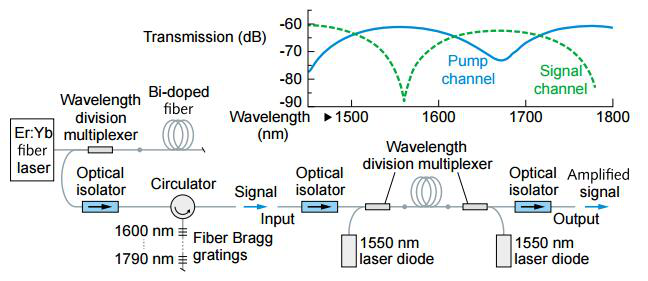Today‘s optical fiber communication networks usually operate at 1550 nm spectral window, and use erbium-doped fiber amplifier (EDFA) to extend communication distance or improve the power of wavelength division multiplexing (WDM) technology.
However, in order to use new spectral windows to meet future communication bandwidth requirements and amplify signals from hollow-core photonic bandgap fibers in the spectral region of 1600-1750 nm, which is not available by EDFA technology, scientists at the Optical Fiber Research Center of the Russian Academy of Sciences have developed a bismuth-doped (Bi) fiber amplifier, which uses a 1550-nm laser diode pump sold in the market. Pu, operating in 1640-1770 nm band.
Although Tm-doped fiber amplifier (TDFA) can operate at 1700nm (and up to 1900nm) windows, it is difficult for TDFA to be used in 1700nm windows because of its low efficiency and strong amplified spontaneous emission (ASE) suppression through various special co-doping and self-made ASE filtering techniques.

As an alternative to TDFA, bismuth-doped germanium silicate fibers can provide amplification at 1700 nm. The research team developed a 1700 nm optical amplifier by developing special bismuth-doped fibers with high germanium content. In order to obtain the optimal gain distribution, several bismuth-doped fibers with different core concentration were fabricated by improved chemical vapor deposition (MCVD).
Bismuth-doped fiber amplifier (BDFA) uses two laser diodes with 150 mW power and 1550 nm wavelength to pump bi-directional fibers with different doping concentration, 125 micron cladding and 2 micron core diameter (see figure). In order to measure the performance of BDFA, a self-made multi-wavelength light source with superluminescent bismuth-doped fiber source and high reflectivity fiber Bragg grating (FBG) was constructed to generate 1615-1795 nm uniform spacing (15nm spacing) spectra.
The performance of 1700nm is based on the measurement of various BDFA performance parameters. In order to obtain the maximum optical gain, it is concluded that 0.015-0.02% of bismuth doping weight is the best choice. An optical amplifier with 50 m bismuth-doped fiber provides 23 dB maximum gain at 1710 nm, 40 nm 3 dB bandwidth, 0.1 dB/mW gain efficiency and about 7 dB minimum noise figure. Compared with TDFA, BDFA has a better 3dB gain bandwidth and efficiency.
"An important issue is to develop fiber amplifiers in new spectral regions where the optical loss of communication fibers is less than 0.4dB/km," said Professor Evgeny Dianov, scientific director of the Optical Fiber Research Center of the Russian Academy of Sciences. "This will make it possible to use extended spectral regions for information transmission in high-speed optical fibre systems. The development of this amplifier is the first major stage in this direction. "In this pursuit, we need to create broadband optical amplifiers with gain bandwidth greater than 100 nm, which will be a new breakthrough in the development of optical communication systems using these amplifiers and active optical fibers," added Dianov.

